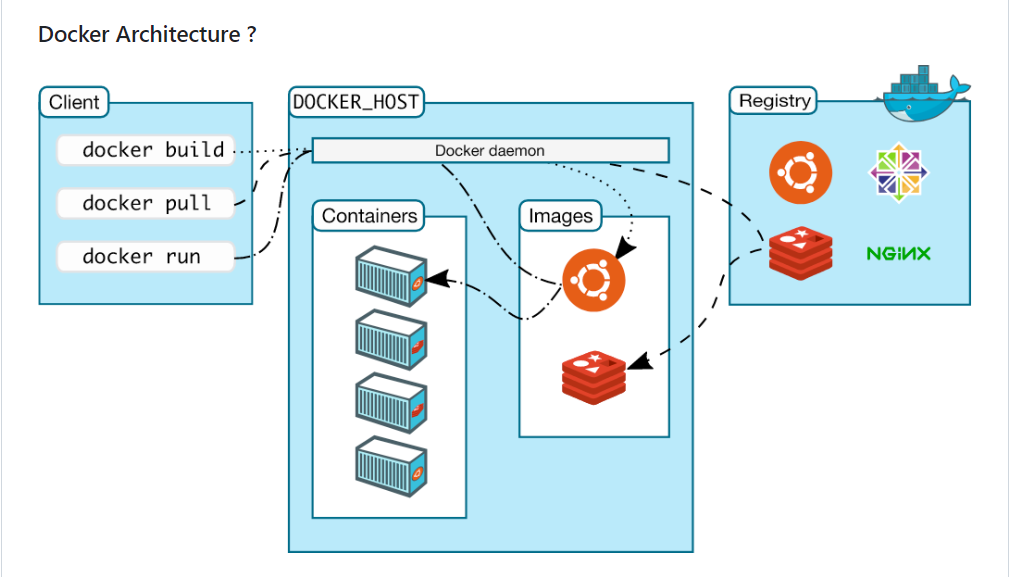Docker Architecture
 Ayushi Vasishtha
Ayushi VasishthaIn the ever-evolving landscape of modern software development, Docker has emerged as a game-changer. It's not just a tool; it's a revolution in how we package, distribute, and deploy applications. At the heart of Docker's magic lies its architecture, a carefully crafted framework that empowers developers to create, manage, and scale applications like never before. Join us as we delve into the core of Docker's architecture and uncover the secrets behind its containerization prowess.
Understanding Docker's Core Components

1. Docker Engine: The Heartbeat of Docker
The Docker Engine serves as the beating heart of the Docker ecosystem. It's the essential element that makes containerization possible. The engine consists of three vital components:
Docker Daemon: This background service manages containers on a host system. It listens for Docker API requests and takes care of container creation, execution, and termination.
REST API: The Docker Daemon exposes a RESTful API that allows users to interact with Docker. Developers, administrators, and tools communicate with the Docker Daemon through these API requests.
Docker CLI: The Command-Line Interface acts as the bridge between users and the Docker Daemon. With the Docker CLI, you issue commands that instruct the Daemon to perform tasks like building images, running containers, and managing networks.
2. Images and Registries: The Building Blocks
An image is a lightweight, standalone package that contains everything an application needs to run – code, runtime, libraries, and system tools. These images are created using Dockerfiles – instructions for building images layer by layer.
Docker images reside in registries, which function as repositories for images. Docker Hub is a popular public registry, while private registries offer enhanced security for organizations. When you use the docker pull or docker run commands, the required images are pulled from your configured registry. When you use the docker push command, your image is pushed to your configured registry.
3. Containers: The Executable Units
Containers are instances of Docker images running in isolated environments. Containers share the host system's kernel but have their own file systems, processes, and network interfaces, ensuring separation and consistency.
In other words, We can say "A container is a standard unit of software that packages up code and all its dependencies so the application runs quickly and reliably from one computing environment to another."
A Docker container image is a lightweight, standalone, executable package of software that includes everything needed to run an application: code, runtime, system tools, system libraries and settings.
4. Dockerfile
A Dockerfile is a plain text file that contains a set of instructions for building an image layer by layer. Each instruction in the Dockerfile creates a new layer in the image, which contributes to the image's final state.
A Dockerfile is like a set of instructions for making a container. It tells Docker what base image to use, what commands to run, and what files to include.
For example, if you were making a container for a website, the Dockerfile might tell Docker to use an official web server image, copy the files for your website into the container, and start the web server when the container starts.
The Dance of Docker Architecture
The synergy of Docker's core components makes the containerization dance possible:
Creating an Image: Developers use Dockerfiles and the Docker CLI to build images. Docker reads the Dockerfile, layers the necessary components, and produces an image.
Storing Images: Docker images are stored in registries, making them accessible to different environments and teams.
Running Containers: By invoking the Docker CLI, developers can create containers from images. The Docker Daemon ensures containers are isolated and functional.
Container Management: Docker provides tools for managing containers' lifecycles, scaling applications, and orchestrating complex deployments.
Docker LifeCycle
docker build -> builds docker images from Dockerfile
docker run -> runs container from docker images
docker push -> push the container image to public/private registries to share the docker images.

Conclusion
Docker's architecture is a symphony of components that harmonize to simplify application delivery, reduce deployment friction, and foster collaboration. Understanding this architecture empowers developers and DevOps engineers to harness the full potential of containerization.
As you navigate the Docker landscape, remember that its architecture isn't just a set of technicalities – it's the foundation of a paradigm shift in software deployment.
So, dive into Docker's architecture, unlock its potential, and let containerization redefine how you approach software development and deployment. 🐳🚀
Subscribe to my newsletter
Read articles from Ayushi Vasishtha directly inside your inbox. Subscribe to the newsletter, and don't miss out.
Written by

Ayushi Vasishtha
Ayushi Vasishtha
👩💻 Hey there! I'm a DevOps engineer and a tech enthusiast with a passion for sharing knowledge and experiences in the ever-evolving world of software development and infrastructure. As a tech blogger, I love exploring the latest trends and best practices in DevOps, automation, cloud technologies, and continuous integration/delivery. Join me on my blog as I delve into real-world scenarios, offer practical tips, and unravel the complexities of creating seamless software pipelines. Let's build a strong community of tech enthusiasts together and embrace the transformative power of DevOps!